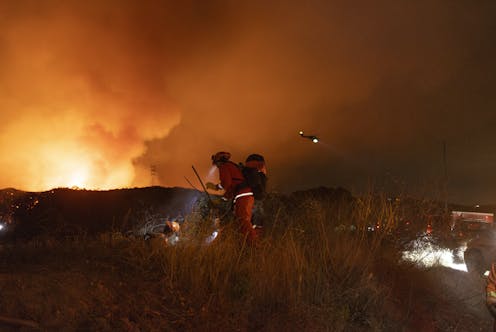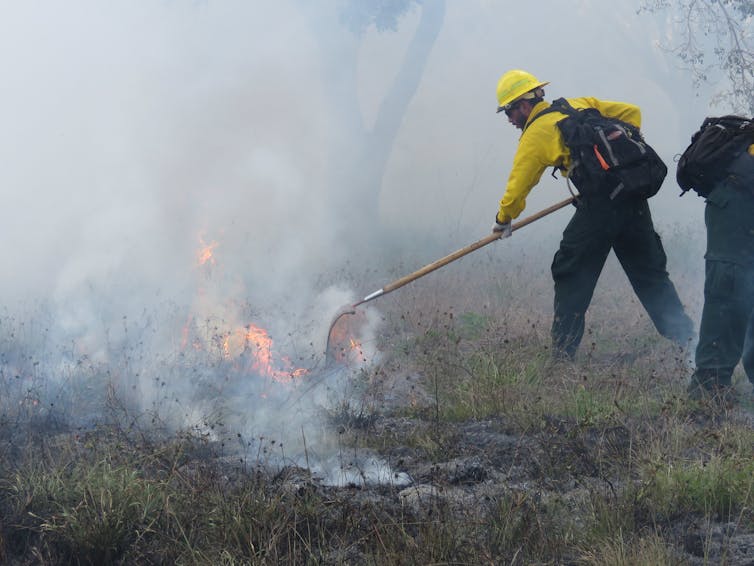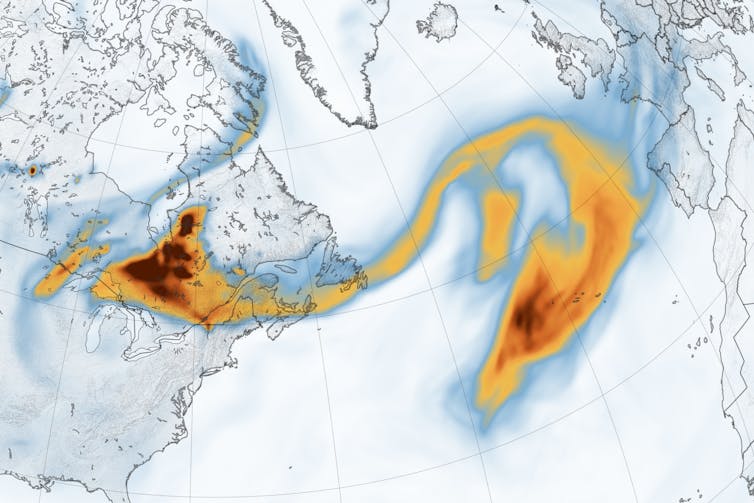Human use of fire has produced an era of uncontrolled burning: Welcome to the Pyrocene
- Written by Stephen Pyne, Emeritus Professor of Life Sciences, Arizona State University
 Firefighters work near the Palisades Fire in Los Angeles on Jan. 11, 2025.Peyman Fakhraei/Middle East Images/AFP via Getty Images
Firefighters work near the Palisades Fire in Los Angeles on Jan. 11, 2025.Peyman Fakhraei/Middle East Images/AFP via Getty ImagesLos Angeles is burning, but it isn’t alone. In recent years, fires have blasted through cities in Colorado, the southern Appalachians and the island of Maui, along with Canada, Australia, Portugal and Greece. What wasn’t burned was smoked in.
Is this another case of a future not only dire but strange, without a narrative to join past to present or an analog for what is to come?
I’m a historian of fire, and my reply is that we have both a narrative and an analog. The narrative is the unbroken saga of humanity and fire, a companionship that extends through all our existence as a species. The analog is that humanity’s fire practices have become so vast, especially in recent centuries, that we are creating the fire equivalent of an ice age.
Fire as organizing principle
Humanity and fire have been reforging the Earth since the end of the last glaciation, about 11,500 years ago. Generally, these changes have made landscapes more fire-receptive.
The scale is significant. Recent studies speculate that massive depopulation, especially in the Americas, which removed the torch and allowed forests to reclaim land and so sequester atmospheric carbon, may have even helped nudge the planet into the Little Ice Age from the mid-16th to mid-19th centuries.
Still, there were limits. Fire and life had coevolved across 420 million years, and ecological checks and balances limited how far humans could push and pull fire within the constraints of terrestrial landscapes.
The process unquestionably quickened and changed character with the wholesale burning of fossil fuels, or what we might term lithic landscapes. This combustion lies outside the old boundaries: It can burn anytime, anywhere, and its effluent isn’t easily absorbed into the old ecology. By warming the atmosphere, it is a leading cause of climate change, which in turn is generally enhancing conditions for wildfires.
Equally important, the transition to a fossil-fuel civilization has affected how people live on the land, how they design cities and peri-urban communities, how they shape living landscapes with agriculture and nature preserves, how they generate and transmit energy, and what kind of fire practices they adopt.
 Firefighters monitor a prescribed fire in Florida’s Everglades National Park in 2018. Prescribed burns are carefully planned to reduce overgrowth and brush and promote growth of plants that depend on fire to thrive. Federal agencies revised policies to encourage controlled burns during the late 1960s and 1970s, but studies show that the practice is still underutilized relative to need.National Park Service
Firefighters monitor a prescribed fire in Florida’s Everglades National Park in 2018. Prescribed burns are carefully planned to reduce overgrowth and brush and promote growth of plants that depend on fire to thrive. Federal agencies revised policies to encourage controlled burns during the late 1960s and 1970s, but studies show that the practice is still underutilized relative to need.National Park ServicePetrochemicals from fossil biomass replace, or try to substitute for, fire’s ecological effects. Energy from fossil fuels displaces the heat, light and power of flame. Instead of challenging wildfire with tamed fire, modern societies fight landscape fire with the counterforce of industrial fire in the form of pumps, engines, bulldozers and aircraft.
This “pyric transition” in types of combustion forces the two different kinds of burning – fires in living landscapes and fires that burn lithic landscapes – to interact in ways that sometimes compete and sometimes collude. Like the power lines that have sparked so many disastrous wildfires, the two realms of fire are crossing, often with lethal consequences.
The prospect for worsening fires because of changing land use and fire practices was apparent before climate change became a serious consideration in the 1990s. U.S. land agencies recognized the ill consequences of removing fire and reformed policies to reinstate good fire over 50 years ago. Unfortunately, bad fire continues to outpace good fire.
As the world burns
No single factor drives fire: It synthesizes its surroundings. It’s like a driverless car that barrels down the road, integrating whatever is around it.
Sometimes it confronts a sharp curve called climate change. Sometimes it’s a tricky intersection where townscape and countryside meet. Sometimes it’s road hazards left from past accidents, such as logging slash, invasive grasses or postburn environments.
Climate change acts as a performance enhancer, and understandably, it claims most of the attention because it’s global and its reach extends beyond flames. But the argument over whether climate or land use is more critical is misguided: They both derive, independently, from the conversion to a fossil-fuel society. Megafires, it seems, feed on modernity as hurricanes feed on warm oceans.
 A plume of black carbon particles, commonly called soot, spans eastward from wildfires in Canada and across more than 2,000 miles of the Atlantic Ocean on June 26, 2023. Red and yellow areas denote the densest concentrations of particles.NASA Earth Observatory
A plume of black carbon particles, commonly called soot, spans eastward from wildfires in Canada and across more than 2,000 miles of the Atlantic Ocean on June 26, 2023. Red and yellow areas denote the densest concentrations of particles.NASA Earth ObservatoryIn the U.S., the pyric transition sparked a wave of monster fires that rode the rails of settlement – fires an order of magnitude larger and more lethal than those of recent decades. Land clearing and logging slash fed serial conflagrations, which blew up in the late 19th and early 20th centuries – the waning decades of the Little Ice Age.
This havoc inspired the federal government to intervene to end the environmental wreckage, spare watersheds and shield communities, all under the aegis of conservation, which became a global project. Fire control was regarded as foundational; suppressing fires became an index of success. Led by foresters, the belief spread that fire on landscapes could be replaced, as was happening in cities, or caged, as it was in furnaces and dynamos.
With natural fire and traditional burning removed from the landscape, the population of fires fell to the point where flames could no longer do the ecological work required. Instead of reducing risk, landscapes became prone to more explosive burning as fuels accumulated on them over decades.
Now, too much fossil biomass is burned to be absorbed within ancient ecological bounds. Fuels in the living landscape pile up and rearrange themselves. The climate is unhinged. When flame returns, as it must, it too often comes as wildfire.
Welcome to the Pyrocene
Widen the aperture a bit, and we can envision Earth entering a fire age comparable to the ice ages of the Pleistocene, complete with the pyric equivalent of ice sheets, pluvial lakes, periglacial outwash plains, mass extinctions and sea-level changes. It’s an epoch in which fire is both prime mover and principal expression.
Humanity’s firepower underpins the Anthropocene, which is the outcome not just of anthropogenic meddling but of a particular kind of meddling, made possible by humans’ species monopoly over fire. Even climate history has become a subset of fire history.
Fires in living landscapes, fires burning lithic landscapes – the interaction of these two realms of fire has not been much studied. It’s been enough of a stretch to fully include human fire practices within traditional ecology. Yet humans – the keystone species for fire on Earth – are merging the two arenas of earthly burning with a give and take that is reshaping the planet in what resembles a slow-motion Ragnarok.
Add up all the effects, direct and indirect: the ice driven off by fire, the areas burning, the biogeographical migrations as biotas move to accommodate changed conditions, the collateral impacts with damaged watersheds and airsheds, the unraveling of ecosystems, the pervasive power of climate change, rising sea levels, a mass extinction, the disruption of human life and habitats. The result is a pyrogeography that looks eerily like an ice age for fire. You have a maturing Pyrocene.
If you doubt it, just ask California.
This article uses material from an article originally published on Nov. 1, 2019.
Stephen Pyne has in the past received funding from U.S. Forest Service, Department of the Interior, and Joint Fire Science Program, and fellowships from the National Endowment for the Humanities.
Authors: Stephen Pyne, Emeritus Professor of Life Sciences, Arizona State University

